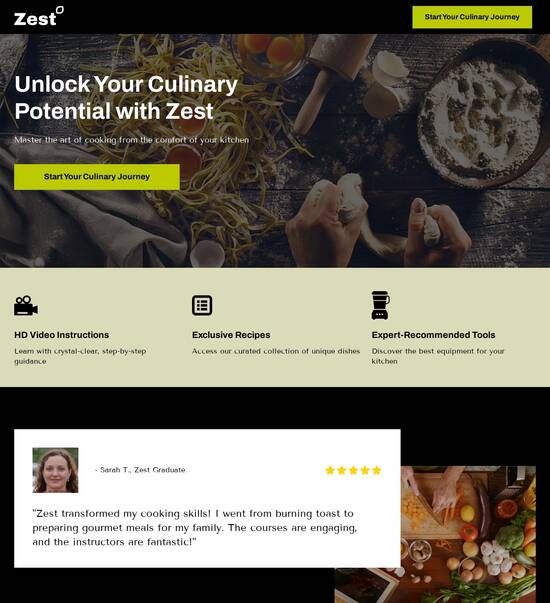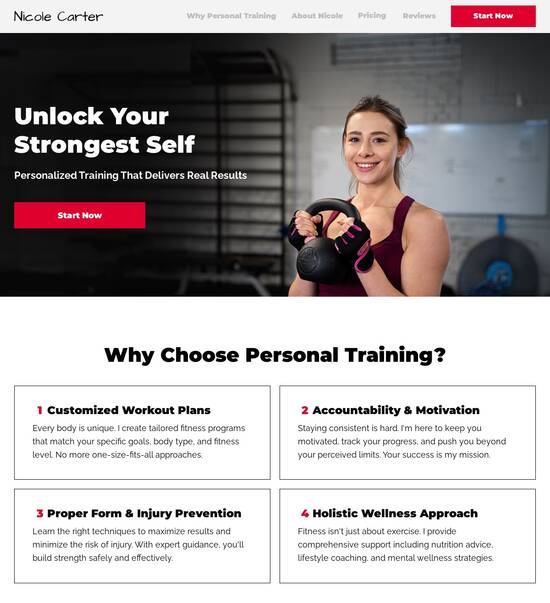
Laravel optimized feedback page template
Explore Similar TemplatesAbout template
Supercharge your feedback page with Laravel for outstanding performance! Learn more today.
Recommended templates

Easy to build without coding
With the intuitive drag-and-drop builder, anyone on your team can create high-converting pages without any knowledge of code or design. Make enhancements to your landing page with custom widgets using Javascript, HTML/CSS, or third-party scripts.

Multiple layouts for any industry and goal
Select from 500+ landing page layouts built to boost conversions across industry-specific scenarios. Customize them by adjusting fonts, adding images, and generating on-brand content with the AI assistant. Quickly scale with Instablocks® and Global Blocks that you can save, reuse, and update globally.

Loads fast and looks polished on any device
Every template is responsive, which means they present professionally on any device and load blazingly fast with our Thor Render Engine. You can also power them up with Google AMP technology to deliver an unparalleled mobile experience and drive higher conversions.

Robust analytics & experimentation
Get real-time updates and reporting across all your devices, showing the number of visitors, conversions, cost-per-visitor, and cost-per-lead. Launch AI-powered experiments, run A/B tests, and use heatmaps to analyze user behavior, then optimize your landing page to maximize conversions.







Easy to build without coding
With the intuitive drag-and-drop builder, anyone on your team can create high-converting pages without any knowledge of code or design. Make enhancements to your landing page with custom widgets using Javascript, HTML/CSS, or third-party scripts.
Multiple layouts for any industry and goal
Select from 500+ landing page layouts built to boost conversions across industry-specific scenarios. Customize them by adjusting fonts, adding images, and generating on-brand content with the AI assistant. Quickly scale with Instablocks® and Global Blocks that you can save, reuse, and update globally.
Loads fast and looks polished on any device
Every template is responsive, which means they present professionally on any device and load blazingly fast with our Thor Render Engine.
Robust analytics & experimentation
Get real-time updates and reporting across all your devices, showing the number of visitors, conversions, cost-per-visitor, and cost-per-lead. Launch AI-powered experiments, run A/B tests, and use heatmaps to analyze user behavior, then optimize your landing page to maximize conversions.
All the features you need to build lead-generating landing pages
Explore more featuresLearn how to build top-performing landing pages for any goal
FAQs
Leading the way in building high-performing landing pages





An introduction to Instapage's powerful landing page functionality
Instapage is the ultimate landing page and conversion rate optimization (CRO) platform that allows marketers to accelerate their campaign efforts effectively. With customizable templates and user-friendly features, optimizing your marketing strategies has never been easier. Instapage combines pivotal tools that cater to every marketing budget and team size, placing emphasis on maximizing the return on investment (ROI) for your digital campaigns.
Understanding the importance of landing pages
Landing pages are crucial to drive conversions and leads. They serve as dedicated spaces where potential customers can be directed from ads or links, providing focused content that encourages desired actions, such as signing up or making a purchase. Here’s why choosing the right landing page platform is vital:
- Customization options: Tailor your landing page to resonate with your audience by utilizing various layouts and themes.
- A/B testing capabilities: Optimize performance through experimentation, discovering which versions yield the best results.
- Analytics insights: Access data-driven insights to enhance user engagement and conversions.
Step 1: Get started with Instapage
Creating an account with Instapage is straightforward. Here’s how you can kick-start your journey:
- Sign up: Visit the Instapage website, and choose a pricing plan that fits your needs to create your account.
- Explore the dashboard: Familiarize yourself with the various features available, from templates to analytics.
- Select a template: Choose from Instapage's library of over 100 high-converting landing page templates that suit your campaign goals.
Step 2: Optimize your landing pages
Once you have your landing page set up, you’ll want to ensure it’s optimized for performance. Here’s how to proceed:
- Implement A/B testing: Create variations of your page to determine which elements resonate more with your audience.
- Utilize heatmaps: Visualize user interactions on your pages for better understanding of their journeys and behavior.
- Analyze results: Study the performance metrics provided by Instapage’s analytics dashboard for future optimization.
Step 3: Personalize the user experience
Personalization is key to enhancing engagement with your audience. Here’s how to ensure each visitor has a tailored experience:
- Dynamic content: Use dynamic text replacement to show relevant content based on demographics or behavior.
- Ad alignment: With AdMaps, align specific ads to landing pages for a coherent user journey.
- Audience metrics: Monitor interactions at the audience level to make informed decisions based on specific audience segments.
By implementing Instapage’s powerful tools, you set yourself on a path to campaign success with a high ROI.
Ready to enhance your landing page performance? Start your free trial with Instapage today and experience the difference!
Transforming user interactions with Laravel's optimized feedback page template
Understanding the need for feedback pages in Laravel applications
User feedback serves as a critical component in enhancing digital services, providing rich insights into user experiences. By gathering feedback, businesses can pinpoint areas for improvement, enhance customer satisfaction, and ultimately drive product evolution.
Statistics reveal that organizations actively seeking user input have significantly greater success in product improvement. For instance, businesses that incorporate customer feedback can see a conversion rate increase of up to 20%, demonstrating the impact of engagement on user retention and loyalty.
Furthermore, capturing feedback plays an essential role in the software development lifecycle. Continuous feedback loops allow developers to adapt features in real time, ensuring that the product closely aligns with user needs.
Overview of Laravel's feedback page capabilities
Laravel stands out for its user-friendly capabilities, particularly in feedback collection. Key features include built-in validation functions that simplify data entry and ensure data integrity, significantly reducing the likelihood of erroneous submissions.
The Eloquent ORM also plays a vital role in managing feedback data effectively. With this powerful tool, developers can easily handle input, store it in the database, and retrieve it when needed, all while maintaining clean and organized code.
Moreover, Laravel offers extensive customization options for feedback pages. Developers can tailor layouts, colors, and functionalities to align with the application's branding, ensuring a seamless user experience.
The evolution of feedback mechanisms: From basic forms to optimized templates
Over the years, feedback collection has transformed from rudimentary manual surveys to sophisticated automated systems. Earlier, companies relied on paper forms and telephone surveys, which were time-consuming and often failed to gather comprehensive insights.
With the advent of technology, automated feedback systems have gained traction. For instance, optimized feedback page templates in Laravel significantly enhance user interactions by providing intuitive interfaces that encourage user participation.
Improved user engagement through streamlined processes.
Faster data collection, which translates to timely decision-making.
Ability to analyze feedback in real-time for immediate feedback-driven enhancements.
Case studies illustrate the power of optimized feedback templates. Companies utilizing such frameworks have reported notable improvements in user satisfaction scores, leading to greater retention rates.
Designing the perfect feedback page template: Key considerations
An effective feedback page must incorporate essential design elements that promote simplicity and clarity. Users appreciate a clean layout where feedback fields are prominently placed, minimizing confusion and guiding them through the process.
User experience (UX) best practices are crucial in feedback page design. This includes adherence to accessibility standards, ensuring that all users can participate, regardless of their physical abilities. Moreover, mobile responsiveness is vital, as an increasing number of users access websites from their smartphones.
Incorporate clear instructions for users at every step.
Use contrasting colors for feedback fields to promote visibility.
Implement user testing to gather insights on design effectiveness.
Additionally, localization plays a significant role in feedback page design. Tailoring requests based on user location and language preferences can greatly increase the likelihood of response and ensure responses are culturally relevant.
Crafting an engaging feedback form: Step-by-step instructions
Creating an engaging feedback form begins with selecting the appropriate fields for your audience. Carefully consider what information you truly need from users to make informed decisions, balancing between simplicity and thoroughness.
Utilizing Laravel’s form requests for validation ensures data integrity by automatically filtering out invalid inputs. This feature can significantly reduce the workload associated with manual data cleaning, allowing your team to focus on actionable insights.
Next, implementing AJAX enhances the user experience by allowing for seamless submissions without disrupting the user flow. This technique makes it feel as if feedback is given instantaneously, which can encourage more users to participate.
Step 1: Choose relevant fields tailored to your audience.
Step 2: Utilize Laravel's form requests for effective validation.
Step 3: Implement AJAX for a smoother user submission experience.
Step 4: Style your feedback template using Laravel Blade.
Step 5: Deploy your feedback template within the Laravel app.
Lastly, spend time styling your feedback template using Laravel Blade to create a visually appealing interface that invites users to share their thoughts.
Integrating feedback into the development process
Once feedback is collected, the real work begins in integrating that input into the development process. Feedback should inform team decisions around product features, UI adjustments, and overall user strategy. This cyclic nature of implementation ensures continual alignment with user needs.
Different teams, including product management, marketing, and technical support, are often responsible for analyzing feedback and translating it into actionable strategies. This collaborative approach ensures that data is comprehensively understood across departments.
Establish regular meetings to discuss feedback results.
Encourage department heads to share user insights relevant to their teams.
Create a shared document or digital space for accumulating user feedback.
Additionally, it’s crucial to implement best practices for feedback follow-ups. Inform users about changes made as a result of their input; this not only fosters a sense of involvement but also builds trust and loyalty.
Leveraging community insights for continuous improvement
Staying connected with Laravel communities can drastically enhance the optimization of feedback pages. Engaging in forums and utilizing social media allows for the sharing of best practices, innovative ideas, and common challenges faced during implementation.
Furthermore, leveraging emerging technologies like AI and data visualization tools can provide deeper insights into feedback analysis. These tools can automate categorization and help teams make sense of large data sets more efficiently.
Participate in online meetups to learn from peers.
Contribute to open-source projects focused on feedback collection.
Share your experiences on public forums to help others.
By actively participating in the Laravel community and utilizing technology, organizations can continually refine their feedback processes.
Analyzing feedback: Turning responses into actionable data
Once feedback is collected, sorting and categorizing responses into actionable insights becomes paramount. Different techniques can be used, such as tagging responses with keywords relevant to specific topics, allowing for easier navigation when analyzing data trends.
Employing qualitative and quantitative methods yields a 360-degree understanding of user sentiment. Surveys, rating scales, and open-ended questions provide rich data points that, when properly analyzed, can lead to valuable product insights.
Utilize software tools for data categorization.
Apply sentiment analysis techniques for qualitative responses.
Conduct regular benchmarking exercises to compare feedback over time.
Additionally, investing in tools that automate feedback analysis will save teams time and allow for quicker responses to user needs.
Building a culture of feedback within teams
Establishing an environment that encourages open communication about user experiences is essential for continuous improvement. Creating avenues where team members can express insights gained from user feedback fosters collaboration and innovation.
Implementing practices for sharing feedback can lead to proactive identification of trends and issues. Teams should celebrate successes derived from user input as much as they address challenges, creating a positivity-driven cycle.
Organize regular feedback sessions for team members to share insights.
Create recognition programs for teams implementing user-driven changes.
Develop a system for documenting user feedback trends over time.
By nurturing a culture centered around feedback, companies are better positioned to adapt and thrive in their respective markets.
Documentation and knowledge sharing: Creating a feedback playbook
Comprehensive documentation of the entire feedback process is vital for teams to understand how to gather, analyze, and act on feedback effectively. This ensures that practices are consistent and replicable, which is particularly important when onboarding new team members.
Creating a knowledge base allows team members to reference best practices and learn from past experiences. This resource should be updated regularly as new processes emerge and insights are gained.
Establish standard operating procedures for feedback collection.
Utilize collaborative tools to share documentation across teams.
Encourage feedback on the documentation process to refine it further.
In doing so, companies ensure that all members understand their role in the feedback cycle, leading to a more cohesive approach.
Case studies: Real-world implementations of feedback pages in Laravel
Analyzing real-world implementations reveals the impact effective feedback systems can have on user engagement. For instance, a SaaS company implemented an optimized feedback template in Laravel that resulted in a 25% increase in user-generated input.
Conversely, another company faced challenges with its feedback engagement. By simplifying its feedback forms and implementing A/B testing for different templates, they were able to pivot and increase responses by 15% in under two months.
Success stories often highlight increased user engagement metrics.
Challenges faced may include complex forms and user disengagement.
Lessons learned can apply across sectors, including e-commerce and education.
These insights highlight the importance of continuous testing and adaptation in feedback page design, which leads to richer user interactions.
Best practices for maintaining and evolving the feedback page
Regular updates to feedback forms are crucial for maintaining relevance. As user preferences change, it’s important to iterate and revise questions accordingly. Conducting periodic reviews ensures feedback remains valuable.
A/B testing different feedback templates provides insights into which formats yield higher engagement. Experimenting with layouts, color schemes, and question types can identify clear directional improvements on existing templates.
Schedule systematic reviews of feedback questions.
Utilize analytics to determine the performance of different templates.
Engage users directly to get insights on what they find useful.
By maintaining a cycle of feedback and iteration, feedback pages can stay current, ensuring they effectively capture user insights.
Future technologies influencing feedback collection in Laravel
Looking forward, emerging technologies like machine learning and advanced analytics will play pivotal roles in shaping feedback collection processes. These tools can help in personalizing user interactions based on historical data.
For example, chatbots powered by AI can handle initial feedback inquiries, facilitating a smoother user experience. The integration of such technology could streamline the feedback process and yield higher response rates.
Explore machine learning solutions for enhanced user personalization.
Invest in analytics platforms for richer data visualizations.
Monitor trends in user feedback technology for potential integrations.
Ultimately, these advances will redefine how organizations engage with users, creating more meaningful feedback experiences and promoting an adaptable approach to product management.
Ready to skyrocket conversions?
Supercharge your ad campaigns with high-performing landing pages
Get started














